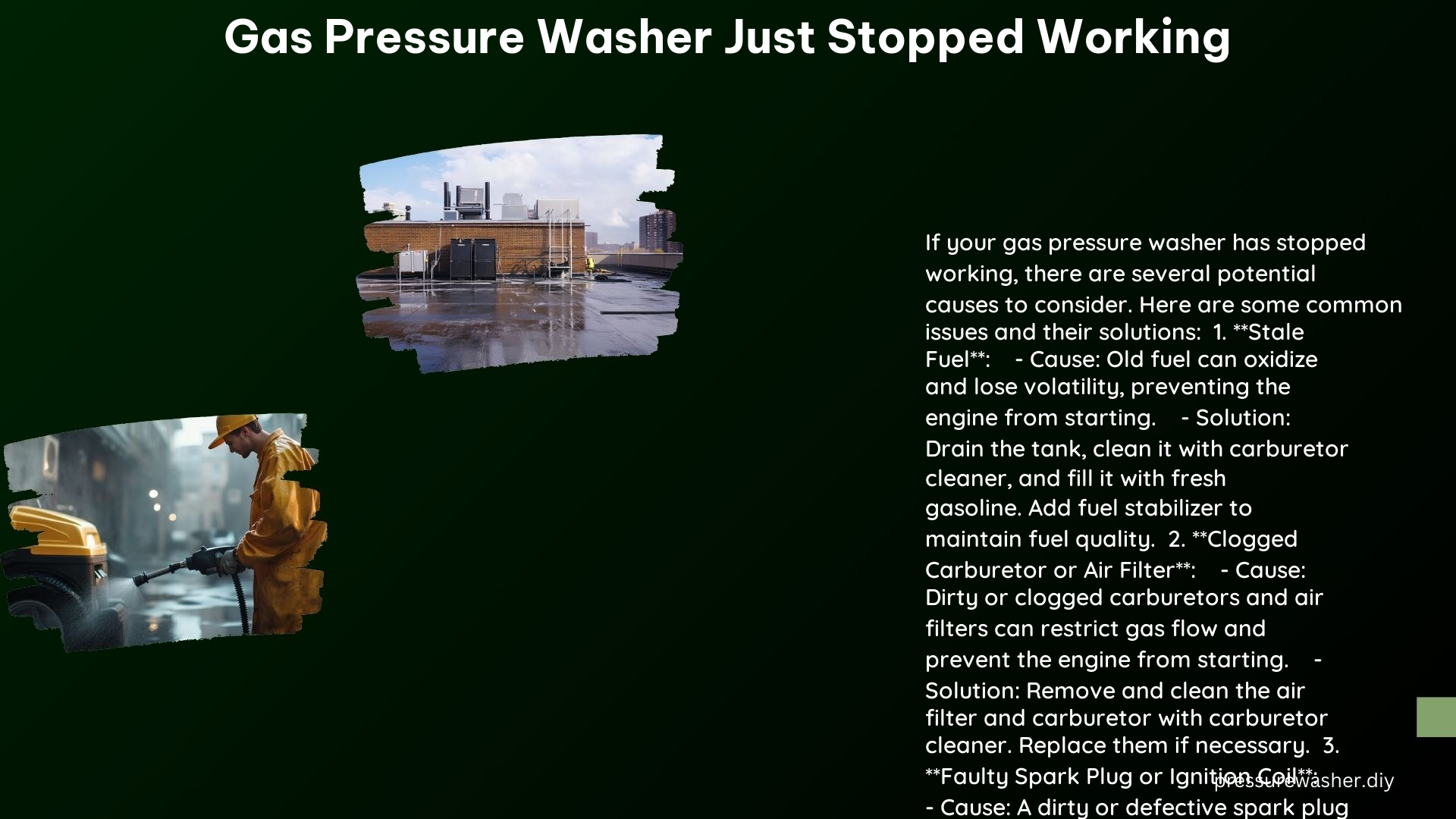If your gas-powered pressure washer has suddenly stopped working, it can be a frustrating experience. However, with the right troubleshooting steps and a deep understanding of the common issues, you can quickly diagnose and resolve the problem. This comprehensive guide will walk you through the most common causes of a non-functioning gas pressure washer and provide detailed solutions to get your equipment back up and running.
Worn Nozzle
One of the primary reasons for a drop in pressure in a gas pressure washer is a worn nozzle. Over time, the orifice size of the nozzle can increase due to wear, reducing the resistance to water flow and resulting in lower pressure. To address this issue, you should replace the nozzle with a properly sized one. Ensure that the new nozzle matches the recommended specifications for your pressure washer model, as using the wrong size can further exacerbate the problem.
Faulty Unloader

The unloader valve is a critical component in a gas pressure washer, responsible for regulating the system pressure. If the piston inside the unloader valve becomes worn or stuck, it can cause excess bypass flow, leading to low system pressure. To fix this issue, you’ll need to inspect and clean or replace the internal piston in the unloader valve. This may require disassembling the valve and carefully examining the components for any signs of wear or damage.
Worn Seals
The reciprocating movement of the pump in a gas pressure washer can cause the seals to wear over time. As the seals deteriorate, they can allow fluid to migrate to the low-pressure side, reducing the overall flow and pressure. To address this problem, you should inspect the seals and replace them as needed, following the service and preventive maintenance recommendations provided by the manufacturer.
Faulty Pressure Gauge
An inaccurate pressure gauge can lead to the perception that the pressure washer is not functioning correctly. This can be caused by gauge failure or over-pressurization of the system. To resolve this issue, replace the pressure gauge with a high-quality, glycerin-filled gauge that can provide reliable and accurate pressure readings.
Belt Slippage
If the belt-drive assembly in your gas pressure washer is experiencing slippage, it can result in a lower pump speed, which in turn reduces the flow and pressure. Inspect the belt-drive assembly, clean any debris or buildup, and replace the belt if necessary. Ensure that the belt tension is properly adjusted according to the manufacturer’s specifications.
Pulsation Dampener Issues
The reciprocating action of the pump plungers or pistons in a gas pressure washer can cause pressure pulsation, which can negatively impact the performance of the equipment. To address this problem, you should install a pulsation dampener or inspect and replace the existing one if necessary. The pulsation dampener helps to smooth out the pressure fluctuations and provide a more consistent flow.
Turbulent Water Supply
Turbulent water entering the pump can cause rough operation and reduce the overall performance of the gas pressure washer. Inspect the inlet line for any restrictions, such as clogged filters or kinks in the hose. Clean or replace the filters as needed and ensure that the water supply is smooth and uninterrupted.
High-Pressure Seal Issues
Worn high-pressure seals can lead to uneven flow, which can impact the pressure and performance of the gas pressure washer. To fix this problem, you’ll need to inspect the high-pressure seals and replace them as a complete set, following the manufacturer’s recommendations for the appropriate seal size and type.
Stale Fuel
Over time, the fuel in the gas pressure washer can become stale, oxidizing and losing its volatility, which can prevent proper combustion. To address this issue, drain the old fuel, clean the fuel tank with a carburetor cleaner, and fill the tank with fresh gasoline.
Clogged Carburetor or Air Filter
A clogged carburetor or air filter can restrict the gas flow, leading to poor engine performance and a lack of power in the gas pressure washer. Clean or replace the carburetor and air filter to ensure proper fuel and air mixture for efficient combustion.
Defective Spark Plug or Ignition Coil
If the spark plug or ignition coil in your gas pressure washer is not functioning correctly, it can prevent the air-fuel mixture from igniting, causing the engine to stop working. Replace the spark plug and ignition coil as needed to restore proper ignition.
Pump Issues
Various pump-related problems, such as clogged nozzles, kinked hoses, or damaged seals, can also contribute to the failure of a gas pressure washer. Inspect the pump components, clean or replace any damaged or worn parts, and ensure that the hoses and nozzles are in good condition.
Air in the System
Air trapped in the pump or hoses can cause pressure loss and prevent the gas pressure washer from functioning properly. To address this issue, bleed the system by running the pump with the trigger gun open until all the air is purged, and the water flow is smooth and consistent.
By following these detailed troubleshooting steps and addressing the common causes of a non-functioning gas pressure washer, you should be able to diagnose and resolve the issue, restoring your equipment to its full performance.
References:
– Cat Pumps. (n.d.). Pressure Washer Troubleshooting. Retrieved from https://www.catpumps.com/pressure-washer-troubleshooting
– Bob Vila. (2022, July 19). Solved My Pressure Washer Won’t Start—How Do I Fix It? Retrieved from https://www.bobvila.com/articles/pressure-washer-wont-start/
– Family Handyman. (2023, June 7). Why Won’t My Gas-Powered Pressure Washer Start? Retrieved from https://www.familyhandyman.com/article/gas-powered-pressure-washer-wont-start/
– Family Handyman. (2021, August 6). Pressure Washer Repair and Troubleshooting. Retrieved from https://www.familyhandyman.com/article/pressure-washer-troubleshooting-and-repair/
